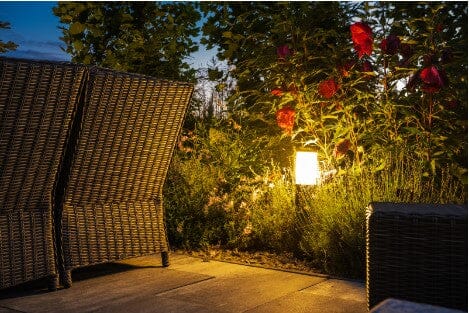
An Easy Guide to Safely Disconnecting and Removing Landscape Lighting
Landscape lighting is a great way to accentuate your outdoor space and create an inviting atmosphere. However, when it comes time to disconnect or remove the lighting, it can be challenging to know how best to do so safely.
This guide will provide step-by-step instructions for safely disconnecting and removing landscape lighting from any yard or garden. It will cover all of the necessary safety precautions that should be taken before beginning the process, as well as specific instructions on how to correctly and efficiently complete the task with minimal risk. This guide gives you everything you need for a successful project!
Landscape Lighting and Its Benefits

Landscape lighting is the practice of illuminating outdoor areas of a property, such as gardens, walkways, and architectural features. The benefits of landscape lighting include the following:
Safety: Properly lit walkways and steps can prevent trips and falls, making the property safer for visitors and residents.
Security: Outdoor lighting can deter burglars and other intruders by making it difficult for them to hide in the shadows.
Aesthetics: Landscape lighting can enhance the beauty of a property by highlighting its architectural features and landscaping.
Functionality: Lighting can extend the usable hours of outdoor spaces and make them more functional for entertaining, dining, and relaxing activities.
Energy efficiency: LED lights are often used for landscape lighting and can be more energy-efficient than traditional incandescent bulbs.
Landscape lighting can make outdoor areas more beautiful, safer, and functional. It can also increase property value.
Safety Precautions to Take Before Disconnecting and Removing Landscape Lighting

Before disconnecting and removing landscape lighting, it is essential to take certain safety precautions to protect yourself and prevent damage to the lighting and surrounding areas. Some safety precautions to take include:
Please turn off the power: Before working on any electrical equipment, it is essential to turn off the power to the circuit or system. This will prevent electrical shock or injury.
Use protective equipment: Wear gloves and safety glasses to protect your hands and eyes from cuts, scrapes, and other hazards.
Use the proper tools: Use the appropriate tools, such as wire cutters and pliers, to disconnect and remove the lighting. Using the wrong tools can cause damage to the lighting or injury to yourself.
Be aware of your surroundings: Be mindful of any overhead power lines or other hazards that could be present in the area. Keep a safe distance from these hazards to prevent accidents.
Be careful of buried lines: Be aware of any buried electrical lines in the area. If you are still determining the location of these lines, it is best to consult with a professional before digging.
Dispose of lighting properly: Dispose of any old or damaged lighting properly. Don't just throw them in the trash, as they might contain hazardous material.
Following these safety precautions, you can protect yourself and prevent damage to the landscape lighting and surrounding areas while disconnecting and removing the lights.
Step-By-Step Instructions for Safely Disconnecting the Wiring

Here are step-by-step instructions for safely disconnecting the wiring for landscape lighting:
Turn off the power: Locate the main electrical panel for the outdoor lighting and turn off the power to the circuit that controls the lights you will be working on.
Locate the transformer: The transformer is the component that reduces the voltage from your home's electrical system to the low voltage used by the landscape lights. It is usually located near the main electrical panel or the lights themselves.
Disconnect the transformer: Unscrew the wire connectors from the transformer and the lights. If the transformer is hardwired, you will need to turn off the power at the main panel and use a voltage tester to ensure the wires are not live before disconnecting them.
Disconnect the lights: Unscrew the wire connectors from the lights and carefully remove the lights from the ground.
Remove the wiring: If it is buried, you must dig it up. However, if it is above ground, you can remove it by cutting it with wire cutters and pulling it out.
Dispose of the old lights: Dispose of the old lights and transformer properly, as they may contain hazardous materials.
Double-check: Before turning the power back on, ensure that you have removed all the lights and wiring and that the circuit is safely disconnected.
By following these steps, you can safely disconnect the wiring for your landscape lighting, reducing the risk of injury or damage. If you need more clarification on any step, it's best to seek professional help.
Tips for Efficiently Removing the Fixtures from Their Locations

Here are some suggestions for efficiently removing the fixtures from their locations in landscape lighting:
Plan: Before you begin, plan the order in which you will remove the fixtures. This will help you work more efficiently and avoid moving back and forth between different areas.
Gather the right tools: Gather all the tools you will need to remove the fixtures, such as a screwdriver, wire cutters, and pliers. This will prevent you from having to stop and search for a tool while you are working.
Remove the bulbs: Before removing the fixtures, remove them and set them aside. This will prevent them from breaking during the removal process.
Use caution: Be careful when removing the fixtures, as they may be heavy or attached to the ground with spikes. Use caution to avoid dropping the fixtures and causing injury or damage.
Label the fixtures: Label them as you remove them so you know where they came from and where they go. This will make it easier to reinstall them later.
Dispose of the old fixtures: Properly dispose of them as they may contain hazardous materials.
Following these tips, you can efficiently and safely remove the fixtures from their locations in landscape lighting. This will allow you to replace them with new fixtures or perform maintenance on the existing ones.
